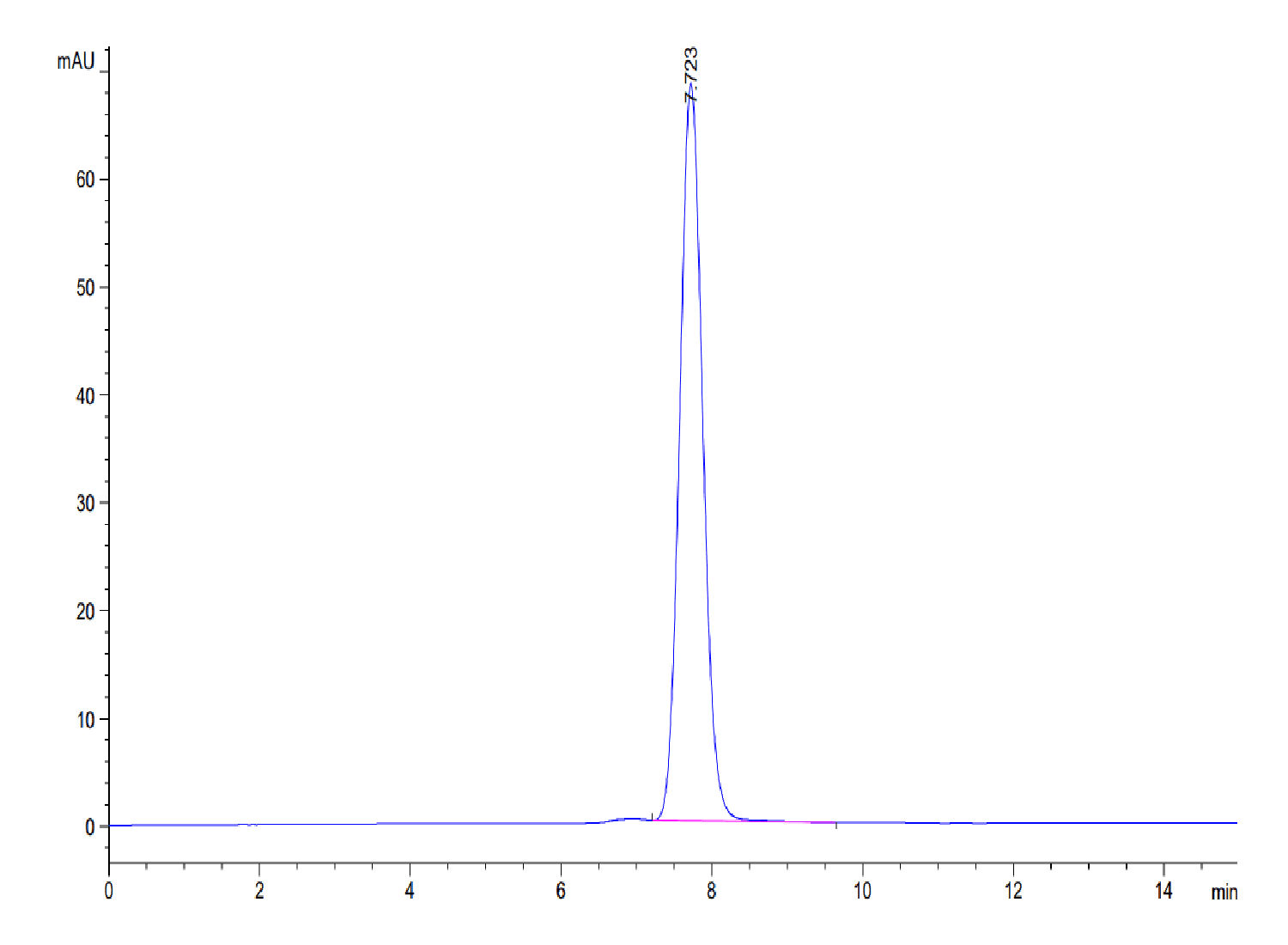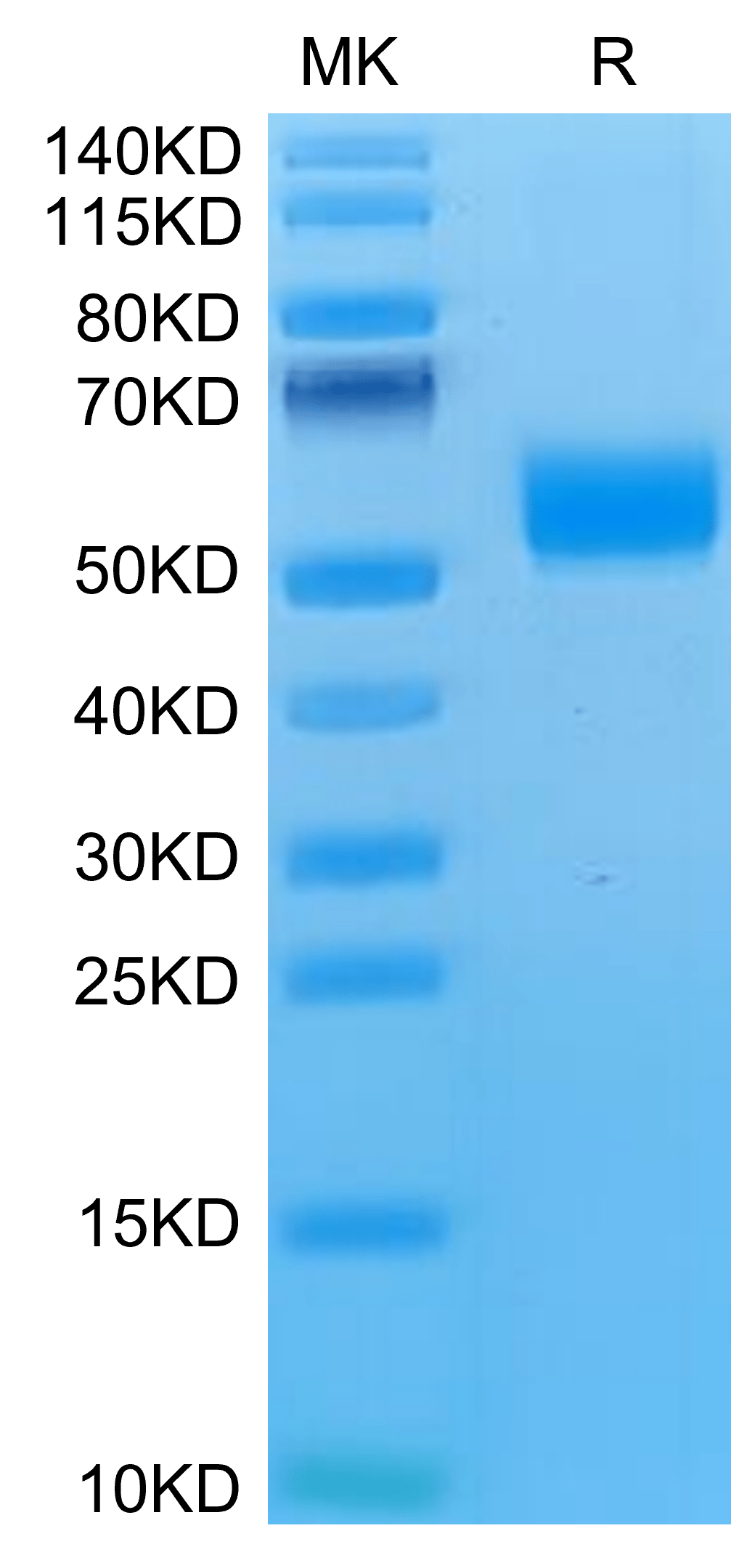| Weight | 1 lbs |
|---|---|
| Dimensions | 9 × 5 × 2 in |
| accession | O54709 |
| express system | HEK293 |
| product tag | N-hFc |
| purity | > 95% as determined by Tris-Bis PAGE;> 95% as determined by HPLC |
| background | NKG2D is a type II transmembrane glycoprotein having an extracellular lectin-like domain. This domain lacks the recognizable calcium-binding sites found in true C-type lectins and binds protein rather than carbohydrate ligands. Human NKG2D is expressed on CD8 alpha beta T cells, gamma δ T cells, NK cells and NKT cells. |
| molecular weight | The protein has a predicted MW of 43.7 kDa. Due to glycosylation, the protein migrates to 50-68 kDa based on Tris-Bis PAGE result. |
| available size | 100 µg, 500 µg |
| endotoxin | Less than 1EU per μg by the LAL method. |
Mouse NKG2D/CD314 Protein 3965
$270.00 – $900.00
Summary
- Expression: HEK293
- Pure: Yes (HPLC)
- Amino Acid Range: Phe90-Val232
Mouse NKG2D/CD314 Protein 3965
| protein |
|---|
| Size and concentration 100, 500µg and lyophilized |
| Form Lyophilized |
| Storage Instructions Valid for 12 months from date of receipt when stored at -80°C. Recommend to aliquot the protein into smaller quantities for optimal storage. Please minimize freeze-thaw cycles. |
| Storage buffer Shipped at ambient temperature. |
| Purity > 95% as determined by Tris-Bis PAGE |
| target relevance |
|---|
| NKG2D is a type II transmembrane glycoprotein having an extracellular lectin-like domain. This domain lacks the recognizable calcium-binding sites found in true C-type lectins and binds protein rather than carbohydrate ligands. Human NKG2D is expressed on CD8 alpha beta T cells, gamma δ T cells, NK cells and NKT cells. |
| Protein names NKG2-D type II integral membrane protein (Killer cell lectin-like receptor subfamily K member 1) (NK cell receptor D) (NKG2-D-activating NK receptor) (CD antigen CD314) |
| Gene names Klrk1,Klrk1 Nkg2d |
| Mass 10090Da |
| Function Functions as an activating and costimulatory receptor involved in immunosurveillance upon binding to various cellular stress-inducible ligands displayed at the surface of autologous tumor cells and virus-infected cells. Provides both stimulatory and costimulatory innate immune responses on activated killer (NK) cells, leading to cytotoxic activity. Acts as a costimulatory receptor for T-cell receptor (TCR) in CD8(+) T-cell-mediated adaptive immune responses by amplifying T-cell activation. Stimulates perforin-mediated elimination of ligand-expressing tumor cells. Signaling involves calcium influx, culminating in the expression of TNF-alpha. Participates in NK cell-mediated bone marrow graft rejection. May play a regulatory role in differentiation and survival of NK cells. Binds to ligands belonging to various subfamilies of MHC class I-related glycoproteins including RAET1A, RAET1B, RAET1C, RAET1D, RAET1E, H60 and MULT1. |
| Catalytic activity #N/A |
| Subellular location Cell membrane ; Single-pass type II membrane protein. Note=Colocalized with HCST and TYROBP on the cell surface. |
| Tissues Expressed in natural killer (NK) cells, activated CD8(+) alpha-beta and gamma-delta T-cells and natural killer T (NKT) cells (at protein level). May be expressed on dendritic cell (DC). Isoform 1 is strongly expressed in natural killer (NK) cells. Isoform 2 is weakly expressed in natural killer (NK) cells. Isoform 1 and isoform 2 are expressed in stimulated, but not in unstimulated, CD8(+) T-cells and macrophages. |
| Structure Homodimer; disulfide-linked. Heterohexamer composed of two subunits of KLRK1 and four subunits of HCST/DAP10 (By similarity). Isoform 1 (via transmembrane domain) interacts with HCST/DAP10; the interaction is required for KLRK1 cell surface expression on activated CD8(+) T-cells, but is dispensable on activated TYROBP-expressing NK cells. Isoform 2 (via transmembrane domain) interacts with HCST/DAP10 (via transmembrane domain); the interaction is required for KLRK1 NK cell surface expression and induces NK cell-mediated cytotoxicity. Isoform 2 (via transmembrane domain) interacts with TYROBP (via transmembrane domain); the interaction is required for KLRK1 NK cell surface expression and induce NK cell-mediated cytotoxicity and cytokine secretion. Isoform 1 does not interact with TYROBP. Interacts with CEACAM1; recruits PTPN6 that dephosphorylates VAV1 (By similarity). |
| Target Relevance information above includes information from UniProt accession: O54709 |
| The UniProt Consortium |
Data
 |
| The purity of Mouse NKG2D is greater than 95% as determined by SEC-HPLC. |
 |
| Mouse NKG2D on Tris-Bis PAGE under reduced condition. The purity is greater than 95%. |
Publications
Publications
| pmid | title | authors | citation |
|---|---|---|---|
| We haven't added any publications to our database yet. | |||
Protocols
| relevant to this product |
|---|
Documents
| # | ||
|---|---|---|
| Please enter your product and batch number here to retrieve product datasheet, SDS, and QC information. | ||














